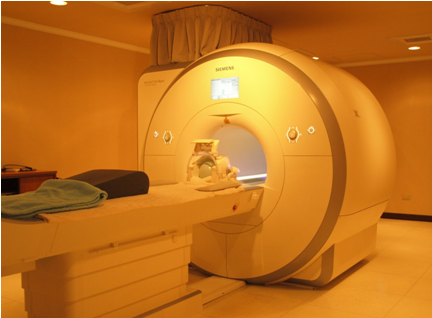MRI
☛Principles of MRI
Magnetic resonance imaging (MRI) uses a magnetic field to magnetize hydrogen nucleus which is primarily in water and fat in the body. When external energy (radiofrequency, near the Larmor (resonance) frequency) is added to the magnetic field, the magnetic vector of hydrogen nuclei is deflected. After turn off the radiofrequency, the magnetic vector has a natural tendency to return to its initial state, and the absorbed energy is emitted in the form of radiofrequency wave. The radio signal can be formed for making detailed image of organs and structures in the body. The radiofrequencies (typically 40-130 MHz) which is found all around us and are not damage tissue as it passes through.
MRI has been widely used in both the medical field and the research field in the recent years because of the advantages of MRI over other imaging modalities include absence of ionizing radiation, superior soft tissue contrast resolution, high-resolution imaging.
☛Principles of fMRI
Functional magnetic resonance imaging or functional MRI (fMRI) measures brain activity by detecting the blood oxygen level–dependent (BOLD) changes that show regional differences in cerebral blood flow to regional activity when occurs following a stimulus or task.
The BOLD signals result from the inhomogeneities within the magnetic field in tissue surrounding the red blood cells, and the inhomogeneities are due to the property of oxygenated blood is diamagnetic and deoxygenated blood is paramagnetic.
fMRI analyses compare the signal difference between the experimental and control conditions using a statistical test, and generate an activation map which is identified the voxels whose signals change synchronized with the stimulus or task.
☛Our MRI
Siemens MAGNETOM Skyra 3 Tesla

Please see the Siemens website for further information about product specifications:
http://www.healthcare.siemens.com/magnetic-resonance-imaging/3t-mri-scanner/magnetom-skyra
☛Coils:
|
|
|
|
|
Head 32 Ch Coil |
Body 32 Ch Coil (In Board) |
Flex Large 4 Ch Coil |
|
Head/Neck 20 Ch Coil |
Body 18 Ch Coil |
Flex Small 4 Ch Coil |
|
Head/Neck 64 Ch Coil |
|
Loop 4 cm Coil |


